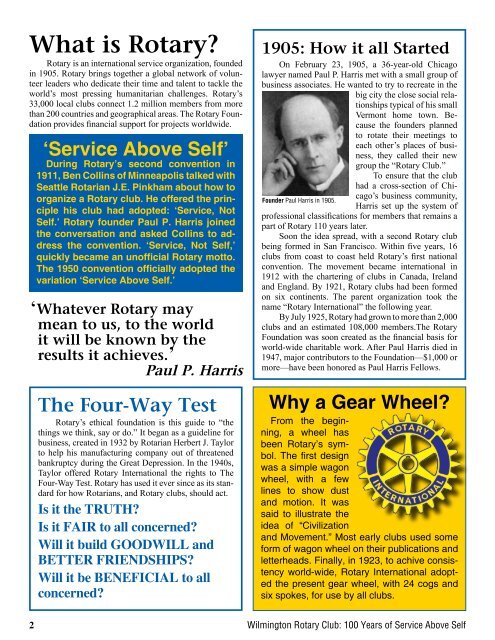Wilmington Rotary Club
Wilmington Rotary Club was establiished in 1915 and - 100 Year Anniversary of service above Self
Wilmington Rotary Club was establiished in 1915 and - 100 Year Anniversary of service above Self
You also want an ePaper? Increase the reach of your titles
YUMPU automatically turns print PDFs into web optimized ePapers that Google loves.
What is <strong>Rotary</strong>?<br />
<strong>Rotary</strong> is an international service organization, founded<br />
in 1905. <strong>Rotary</strong> brings together a global network of volunteer<br />
leaders who dedicate their time and talent to tackle the<br />
world’s most pressing humanitarian challenges. <strong>Rotary</strong>’s<br />
33,000 local clubs connect 1.2 million members from more<br />
than 200 countries and geographical areas. The <strong>Rotary</strong> Foundation<br />
provides financial support for projects worldwide.<br />
‘Service Above Self’<br />
During <strong>Rotary</strong>’s second convention in<br />
1911, Ben Collins of Minneapolis talked with<br />
Seattle Rotarian J.E. Pinkham about how to<br />
organize a <strong>Rotary</strong> club. He offered the principle<br />
his club had adopted: ‘Service, Not<br />
Self.’ <strong>Rotary</strong> founder Paul P. Harris joined<br />
the conversation and asked Collins to address<br />
the convention. ‘Service, Not Self,’<br />
quickly became an unofficial <strong>Rotary</strong> motto.<br />
The 1950 convention officially adopted the<br />
variation ‘Service Above Self.’<br />
‘Whatever <strong>Rotary</strong> may<br />
mean to us, to the world<br />
it will be known by the<br />
results it achieves.’<br />
Paul P. Harris<br />
The Four-Way Test<br />
<strong>Rotary</strong>’s ethical foundation is this guide to “the<br />
things we think, say or do.” It began as a guideline for<br />
business, created in 1932 by Rotarian Herbert J. Taylor<br />
to help his manufacturing company out of threatened<br />
bankruptcy during the Great Depression. In the 1940s,<br />
Taylor offered <strong>Rotary</strong> International the rights to The<br />
Four-Way Test. <strong>Rotary</strong> has used it ever since as its standard<br />
for how Rotarians, and <strong>Rotary</strong> clubs, should act.<br />
Is it the TRUTH?<br />
Is it FAIR to all concerned?<br />
Will it build GOODWILL and<br />
BETTER FRIENDSHIPS?<br />
Will it be BENEFICIAL to all<br />
concerned?<br />
Founder Paul Harris in 1905.<br />
1905: How it all Started<br />
On February 23, 1905, a 36-year-old Chicago<br />
lawyer named Paul P. Harris met with a small group of<br />
business associates. He wanted to try to recreate in the<br />
big city the close social relationships<br />
typical of his small<br />
Vermont home town. Because<br />
the founders planned<br />
to rotate their meetings to<br />
each other’s places of business,<br />
they called their new<br />
group the “<strong>Rotary</strong> <strong>Club</strong>.”<br />
To ensure that the club<br />
had a cross-section of Chicago’s<br />
business community,<br />
Harris set up the system of<br />
professional classifications for members that remains a<br />
part of <strong>Rotary</strong> 110 years later.<br />
Soon the idea spread, with a second <strong>Rotary</strong> club<br />
being formed in San Francisco. Within five years, 16<br />
clubs from coast to coast held <strong>Rotary</strong>’s first national<br />
convention. The movement became international in<br />
1912 with the chartering of clubs in Canada, Ireland<br />
and England. By 1921, <strong>Rotary</strong> clubs had been formed<br />
on six continents. The parent organization took the<br />
name “<strong>Rotary</strong> International” the following year.<br />
By July 1925, <strong>Rotary</strong> had grown to more than 2,000<br />
clubs and an estimated 108,000 members.The <strong>Rotary</strong><br />
Foundation was soon created as the financial basis for<br />
world-wide charitable work. After Paul Harris died in<br />
1947, major contributors to the Foundation—$1,000 or<br />
more—have been honored as Paul Harris Fellows.<br />
Why a Gear Wheel?<br />
From the beginning,<br />
a wheel has<br />
been <strong>Rotary</strong>’s symbol.<br />
The first design<br />
was a simple wagon<br />
wheel, with a few<br />
lines to show dust<br />
and motion. It was<br />
said to illustrate the<br />
idea of “Civilization<br />
and Movement.” Most early clubs used some<br />
form of wagon wheel on their publications and<br />
letterheads. Finally, in 1923, to achive consistency<br />
world-wide, <strong>Rotary</strong> International adopted<br />
the present gear wheel, with 24 cogs and<br />
six spokes, for use by all clubs.<br />
2 <strong>Wilmington</strong> <strong>Rotary</strong> <strong>Club</strong>: 100 Years of Service Above Self



